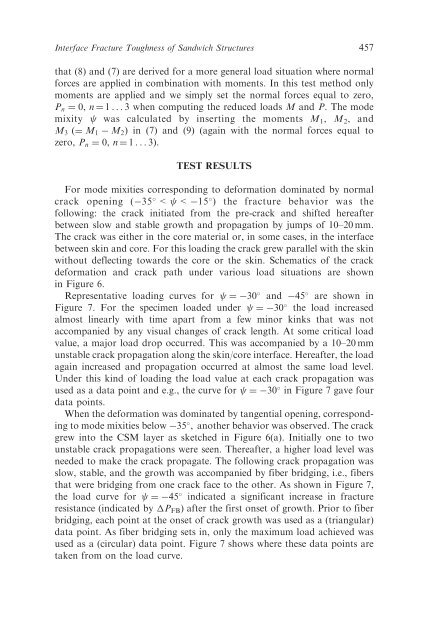Rasmus ÿstergaard forside 100%.indd - Solid Mechanics
Rasmus ÿstergaard forside 100%.indd - Solid Mechanics
Rasmus ÿstergaard forside 100%.indd - Solid Mechanics
You also want an ePaper? Increase the reach of your titles
YUMPU automatically turns print PDFs into web optimized ePapers that Google loves.
Interface Fracture Toughness of Sandwich Structures 457<br />
that (8) and (7) are derived for a more general load situation where normal<br />
forces are applied in combination with moments. In this test method only<br />
moments are applied and we simply set the normal forces equal to zero,<br />
Pn ¼ 0, n ¼ 1 ...3 when computing the reduced loads M and P. The mode<br />
mixity was calculated by inserting the moments M1, M2, and<br />
M3 ð¼ M1 M2Þ in (7) and (9) (again with the normal forces equal to<br />
zero, Pn ¼ 0, n ¼ 1 ...3).<br />
TEST RESULTS<br />
For mode mixities corresponding to deformation dominated by normal<br />
crack opening ( 35 < < 15 ) the fracture behavior was the<br />
following: the crack initiated from the pre-crack and shifted hereafter<br />
between slow and stable growth and propagation by jumps of 10–20 mm.<br />
The crack was either in the core material or, in some cases, in the interface<br />
between skin and core. For this loading the crack grew parallel with the skin<br />
without deflecting towards the core or the skin. Schematics of the crack<br />
deformation and crack path under various load situations are shown<br />
in Figure 6.<br />
Representative loading curves for ¼ 30 and 45 are shown in<br />
Figure 7. For the specimen loaded under ¼ 30 the load increased<br />
almost linearly with time apart from a few minor kinks that was not<br />
accompanied by any visual changes of crack length. At some critical load<br />
value, a major load drop occurred. This was accompanied by a 10–20 mm<br />
unstable crack propagation along the skin/core interface. Hereafter, the load<br />
again increased and propagation occurred at almost the same load level.<br />
Under this kind of loading the load value at each crack propagation was<br />
used as a data point and e.g., the curve for ¼ 30 in Figure 7 gave four<br />
data points.<br />
When the deformation was dominated by tangential opening, corresponding<br />
to mode mixities below 35 , another behavior was observed. The crack<br />
grew into the CSM layer as sketched in Figure 6(a). Initially one to two<br />
unstable crack propagations were seen. Thereafter, a higher load level was<br />
needed to make the crack propagate. The following crack propagation was<br />
slow, stable, and the growth was accompanied by fiber bridging, i.e., fibers<br />
that were bridging from one crack face to the other. As shown in Figure 7,<br />
the load curve for ¼ 45 indicated a significant increase in fracture<br />
resistance (indicated by PFB) after the first onset of growth. Prior to fiber<br />
bridging, each point at the onset of crack growth was used as a (triangular)<br />
data point. As fiber bridging sets in, only the maximum load achieved was<br />
used as a (circular) data point. Figure 7 shows where these data points are<br />
taken from on the load curve.
















